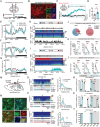Adenosine-Dependent Arousal Induced by Astrocytes in a Brainstem Circuit
- PMID: 39494592
- PMCID: PMC11672293
- DOI: 10.1002/advs.202407706
Adenosine-Dependent Arousal Induced by Astrocytes in a Brainstem Circuit
Abstract
Astrocytes play a crucial role in regulating sleep-wake behavior. However, how astrocytes govern a specific sleep-arousal circuit remains unknown. Here, the authors show that parafacial zone (PZ) astrocytes responded to sleep-wake cycles with state-differential Ca2+ activity, peaking during transitions from sleep to wakefulness. Using chemogenetic and optogenetic approaches, they find that activating PZ astrocytes elicited and sustained wakefulness by prolonging arousal episodes while impeding transitions from wakefulness to non-rapid eye movement (NREM) sleep. Activation of PZ astrocytes specially induced the elevation of extracellular adenosine through the ATP hydrolysis pathway but not equilibrative nucleoside transporter (ENT) mediated transportation. Strikingly, the rise in adenosine levels induced arousal by activating A1 receptors, suggesting a distinct role for adenosine in the PZ beyond its conventional sleep homeostasis modulation observed in the basal forebrain (BF) and cortex. Moreover, at the circuit level, PZ astrocyte activation induced arousal by suppressing the GABA release from the PZGABA neurons, which promote NREM sleep and project to the parabrachial nucleus (PB). Thus, their study unveils a distinctive arousal-promoting effect of astrocytes within the PZ through extracellular adenosine and elucidates the underlying mechanism at the neural circuit level.
Keywords: adenosine; arousal; astrocyte; neural circuit; parafacial zone.
© 2024 The Author(s). Advanced Science published by Wiley‐VCH GmbH.
Conflict of interest statement
Authors declare that they have no competing interests.
Figures







References
-
- Liu D., Dan Y., Annu. Rev. Neurosci. 2019, 42, 27. - PubMed
MeSH terms
Substances
Grants and funding
- 2021ZD0203400/STI2030-Major Projects
- T2293733/National Natural Science Foundation of China Major Project
- T2293730/National Natural Science Foundation of China Major Project
- 31970939/National Natural Science Foundation of China Major Project
- 82288101/National Natural Science Foundation of China Major Project
- 82090033/National Natural Science Foundation of China Major Project
- U20A6005/National Natural Science Foundation of China Major Project
- 32171007/National Natural Science Foundation of China Major Project
- 32100814/National Natural Science Foundation of China Major Project
- LZ22H090001/Natural Science Foundation of Zhejiang Province
- 2024SSYS0019/Key R&D Program of Zhejiang Province
- 2022C03034 to Y.Q.Y/Key R&D Program of Zhejiang Province
- 2024SSYS0017/Key R&D Program of Zhejiang Province
- 2020C03009/Key R&D Program of Zhejiang Province
- 2019-I2M-5-057/CAMS Innovation Fund for Medical Sciences
- 2019B030335001/Key R&D Program of Guangdong Province
- 2023ZFJH01-01/Fundamental Research Funds for the Central Universities
- 2024ZFJH01-01/Fundamental Research Funds for the Central Universities
- 2023-PT310-01/Non-profit Central Research Institute Fund of Chinese Academy of Medical Sciences
LinkOut - more resources
Full Text Sources
Research Materials
Miscellaneous
